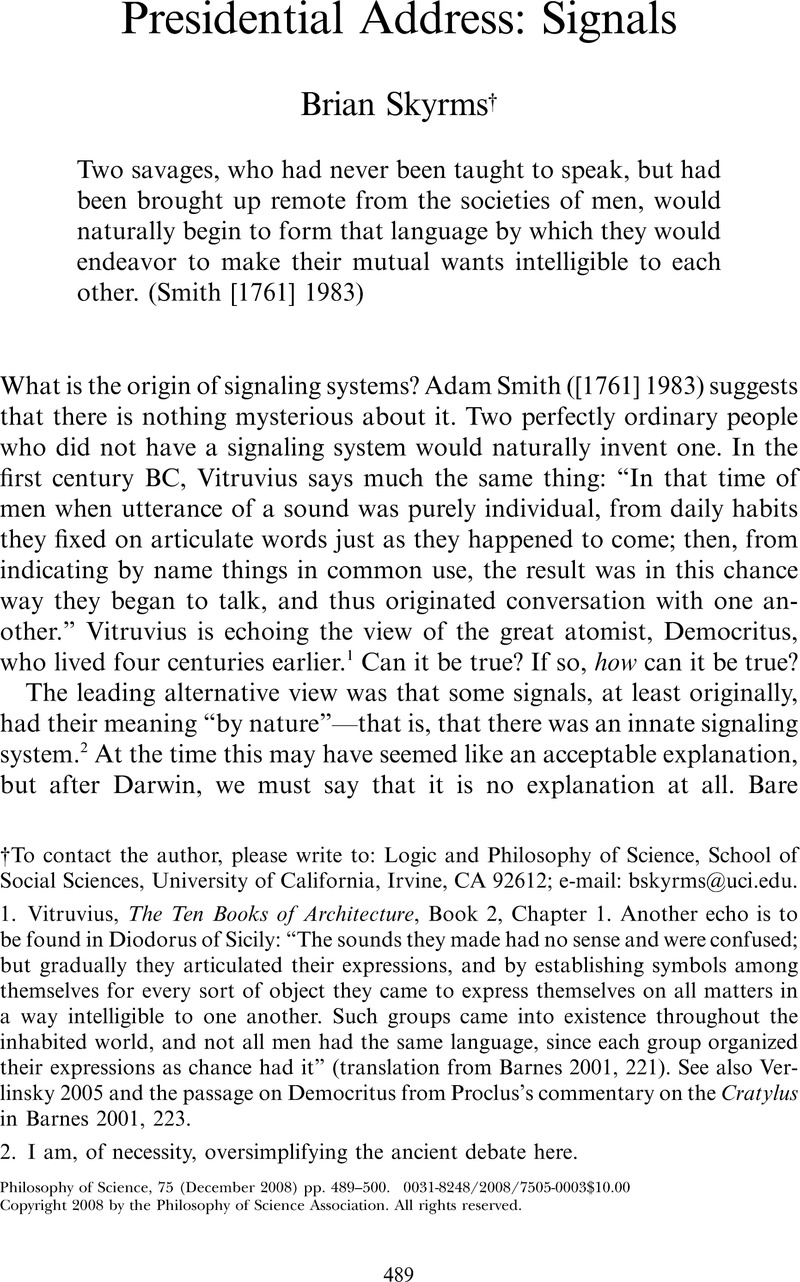Crossref Citations
This article has been cited by the following publications. This list is generated based on data provided by Crossref.
Barrett, Jeffrey
and
Zollman, Kevin J.S.
2009.
The role of forgetting in the evolution and learning of language.
Journal of Experimental & Theoretical Artificial Intelligence,
Vol. 21,
Issue. 4,
p.
293.
Skyrms, Brian
2010.
The flow of information in signaling games.
Philosophical Studies,
Vol. 147,
Issue. 1,
p.
155.
Barrett, Jeffrey A.
2010.
Faithful description and the incommensurability of evolved languages.
Philosophical Studies,
Vol. 147,
Issue. 1,
p.
123.
Skyrms, Brian
2011.
Language, Games, and Evolution.
Vol. 6207,
Issue. ,
p.
177.
Barrett, Jeffrey A.
2013.
The Evolution of Simple Rule-Following.
Biological Theory,
Vol. 8,
Issue. 2,
p.
142.
Barrett, Jeffrey A.
2013.
On the Coevolution of Basic Arithmetic Language and Knowledge.
Erkenntnis,
Vol. 78,
Issue. 5,
p.
1025.
Birch, Jonathan
2014.
Propositional content in signalling systems.
Philosophical Studies,
Vol. 171,
Issue. 3,
p.
493.
Barrett, Jeffrey A.
2014.
On the Coevolution of Theory and Language and the Nature of Successful Inquiry.
Erkenntnis,
Vol. 79,
Issue. S4,
p.
821.
Barrett, Jeffrey A.
2014.
Description and the Problem of Priors.
Erkenntnis,
Vol. 79,
Issue. 6,
p.
1343.
Barrett, Jeffrey A.
and
Skyrms, Brian
2017.
Self-assembling Games.
The British Journal for the Philosophy of Science,
Vol. 68,
Issue. 2,
p.
329.
Barrett, Jeffrey A.
2018.
The evolution, appropriation, and composition of rules.
Synthese,
Vol. 195,
Issue. 2,
p.
623.
Barrett, Jeffrey A.
Cochran, Calvin
and
Skyrms, Brian
2020.
On the Evolution of Compositional Language.
Philosophy of Science,
Vol. 87,
Issue. 5,
p.
910.
Barrett, Jeffrey
2021.
Language and Scientific Research.
p.
121.
Barrett, Jeffrey A.
and
VanDrunen, Jacob
2022.
Language games and the emergence of discourse.
Synthese,
Vol. 200,
Issue. 2,
Barrett, Jeffrey A.
and
LaCroix, Travis
2022.
Epistemology and the Structure of Language.
Erkenntnis,
Vol. 87,
Issue. 2,
p.
953.
Barrett, Jeffrey A.
2023.
Self-Assembling Games and the Evolution of Salience.
The British Journal for the Philosophy of Science,
Vol. 74,
Issue. 1,
p.
75.
Purves, Gordon Michael
2023.
Conventionality and Causality in Lewis-Type Evolutionary Prediction Games.
The British Journal for the Philosophy of Science,
Vol. 74,
Issue. 1,
p.
199.
Matczak, Marcin
2024.
Constitutive conventions in law and the problem of their primacy.
Revus,
Vol. 53,
Issue. ,
Werner, Konrad
2024.
Confined Truths and Cognitive Ecologies: When the Social Pursuit of Questioning Becomes Unreliable.
Topoi,
Barrett, Jeffrey A.
and
Gabriel, Nathan
2024.
Reinforcement with iterative punishment.
Journal of Experimental & Theoretical Artificial Intelligence,
Vol. 36,
Issue. 7,
p.
1361.



